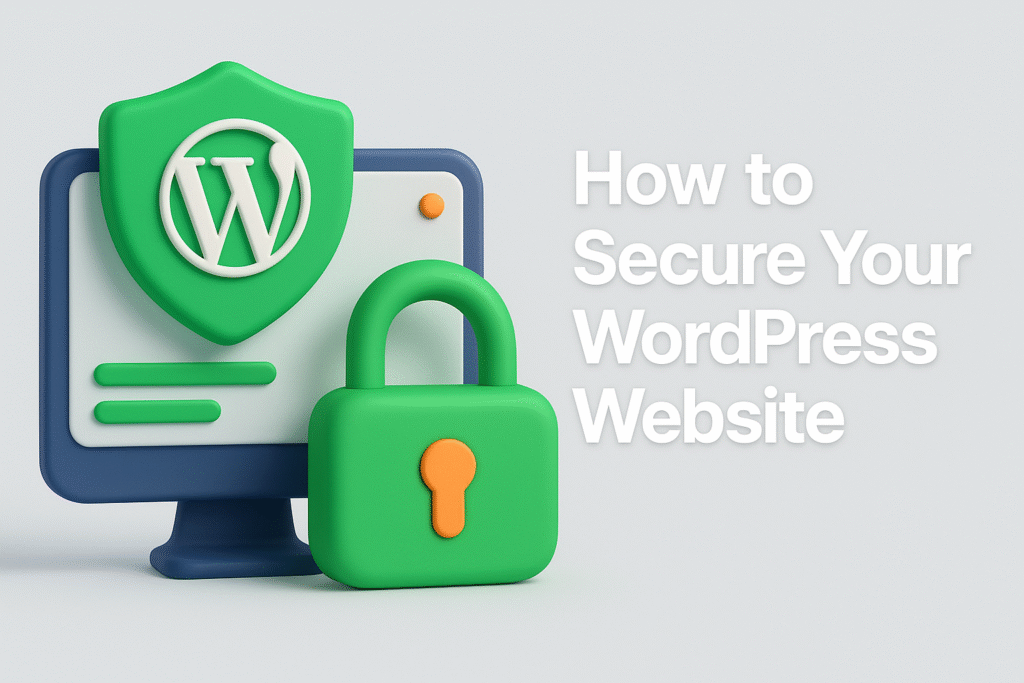How to Secure Your WordPress Website in 2025: A Comprehensive Guide
In the ever-evolving world of cybersecurity, securing your WordPress website is more critical than ever. With hackers becoming increasingly sophisticated, website owners must stay ahead of the curve to protect their data, users, and reputation. In this blog post, we’ll walk you through the essential steps to secure your WordPress website in 2025, ensuring it remains safe from common and emerging threats.
1. Use Strong Passwords and Enable Two-Factor Authentication (2FA)
Why it’s important:
Weak passwords are one of the easiest ways for hackers to gain access to your website. In 2025, brute force attacks will continue to target weak credentials, making strong passwords and 2FA essential.
How to do it:
- Use a password manager to generate and store complex passwords (e.g., 16+ characters with a mix of letters, numbers, and symbols).
- Avoid using common words, phrases, or easily guessable information.
- Enable Two-Factor Authentication (2FA) using plugins like Google Authenticator, Duo Two-Factor Authentication, or Wordfence. 2FA adds an extra layer of security by requiring a second form of verification, such as a code sent to your phone or email.
2. Keep WordPress Core, Themes, and Plugins Updated
Why it’s important:
Outdated software is a goldmine for hackers. Vulnerabilities in WordPress core, themes, and plugins are often exploited to gain unauthorized access.
How to do it:
- Regularly update WordPress to the latest version.
- Update all themes and plugins as soon as new versions are released.
- Remove unused themes and plugins to reduce your attack surface.
- Enable automatic updates for WordPress core, themes, and plugins if possible.
3. Use Security Plugins
Why it’s important:
Security plugins provide an additional layer of protection by monitoring your website for suspicious activity, blocking malicious traffic, and hardening your site’s security.
How to do it:
Install and configure a reputable security plugin like:
- Wordfence: Offers firewall protection, malware scanning, and login security.
- Solid Security: Provides brute force protection, file change detection, and 2FA.
- Sucuri Security: Focuses on malware removal, blacklist monitoring, and security hardening.
4. Disable XML-RPC to Avoid Brute Force Attacks
Why it’s important:
XML-RPC is a feature that allows remote access to your WordPress site. While it can be useful, it’s often exploited for brute force attacks and DDoS attacks.
How to do it:
- Use a security plugin like Wordfence to disable XML-RPC.
- Alternatively, add the following code to your
.htaccessfile:<Files xmlrpc.php> Order Allow,Deny Deny from all </Files>
5. Sanitize All Input Fields to Avoid XSS Attacks
Why it’s important:
Cross-Site Scripting (XSS) attacks occur when hackers inject malicious scripts into input fields (e.g., comment forms, search bars). Sanitizing input fields prevents this.
How to do it:
- Use WordPress functions like
sanitize_text_field(),esc_html(), andesc_url()to sanitize user inputs. - Validate and sanitize all data before saving it to your database.
- Use security plugins that include XSS protection.
6. Disable JSON API to Prevent Admin Username Exposure
Why it’s important:
The WordPress REST API (JSON API) can expose sensitive information, such as admin usernames, making it easier for hackers to target your site.
How to do it:
- Use a plugin like Disable REST API to restrict access to the REST API.
- Alternatively, add the following code to your
functions.phpfile:add_filter('rest_authentication_errors', 'disable_rest_api'); function disable_rest_api($access) { return new WP_Error('rest_disabled', __('REST API is disabled.'), array('status' => 403)); }
7. Hide or Change Your Default Admin Login URL
Why it’s important:
The default login URL (/wp-admin or /wp-login.php) is well-known to hackers. Changing it reduces the risk of brute force attacks.
How to do it:
- Use a plugin like WPS Hide Login to change your login URL to something unique (e.g.,
/my-secret-login). - Avoid using easily guessable URLs.
8. Disable Directory Browsing
Why it’s important:
Directory browsing allows anyone to view the files in your directories, which can expose sensitive information.
How to do it:
- Add the following line to your
.htaccessfile:Options -Indexes
9. Use reCAPTCHA to Block Bots
Why it’s important:
Bots can spam your forms, attempt brute force attacks, or scrape your content. reCAPTCHA helps distinguish between humans and bots.
How to do it:
- Use a plugin like Google reCAPTCHA to add reCAPTCHA to your login, registration, and comment forms.
- Choose the “I am not a robot” checkbox or invisible reCAPTCHA for a seamless user experience.
10. Use an SSL Certificate
Why it’s important:
An SSL certificate encrypts data between your website and its visitors, protecting sensitive information like login credentials and payment details.
How to do it:
- Purchase an SSL certificate from your hosting provider or a third-party vendor.
- Many hosting providers offer free SSL certificates via Let’s Encrypt.
- Ensure your site is configured to use HTTPS by updating your WordPress settings and using a plugin like Really Simple SSL.
11. Perform Regular Penetration Testing
Why it’s important:
Penetration testing helps identify vulnerabilities in your website before hackers can exploit them.
How to do it:
- Contact us to Hire a professional penetration tester to conduct a thorough assessment.
- Regularly test your website after making significant changes or updates.
12. Backup Your Website Regularly: Use Plugins Like WPvivid to Schedule Automatic Backups
Why it’s important:
Regular backups are your safety net in case of a security breach, hacking attempt, or even accidental data loss. If your website is compromised, having a recent backup ensures you can quickly restore it to its previous state without losing critical data.
How to do it:
- Install a reliable backup plugin like WPvivid Backup . This plugin allows you to create full backups of your website, including your database, themes, plugins, and media files.
- Schedule automatic backups to ensure your website is backed up daily, weekly, or monthly, depending on how frequently your content is updated.
- Store backups in secure, offsite locations such as cloud services (e.g., Google Drive, Dropbox, or Amazon S3) to protect against server failures or physical damage.
- Test your backups periodically to ensure they can be restored successfully.
Bonus Tips for Enhanced Security
- Limit Login Attempts: Use a plugin like Limit Login Attempts Reloaded to block IPs after a certain number of failed login attempts.
- Monitor File Integrity: Use security plugins to monitor changes to your core files.
- Use a Web Application Firewall (WAF): Services like Cloudflare or Sucuri Firewall can block malicious traffic before it reaches your site.
- Disable File Editing: Prevent users from editing theme and plugin files by adding
define('DISALLOW_FILE_EDIT', true);to yourwp-config.phpfile. - Monitor Your Website’s Live Traffic, Logs, and Real-Time Activity : Monitoring your website’s live traffic and logs allows you to identify suspicious activity in real-time. By keeping an eye on who is accessing your site and what they are doing, you can detect and respond to potential threats before they escalate.
Conclusion
Securing your WordPress website in 2025 requires a proactive approach. By following the steps outlined in this guide ,using strong passwords, enabling 2FA, keeping your software updated, and employing security plugins,you can significantly reduce the risk of cyberattacks. Additionally, advanced measures like disabling XML-RPC, sanitizing input fields, and performing penetration testing will ensure your website remains resilient against emerging threats.
Remember, cybersecurity is an ongoing process. Stay informed about the latest threats and best practices to keep your WordPress website safe and secure. Happy securing! 🛡️



